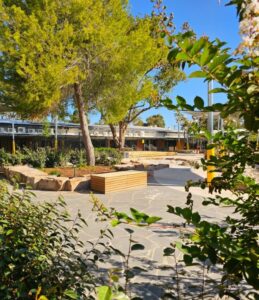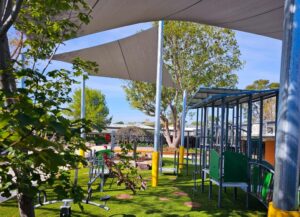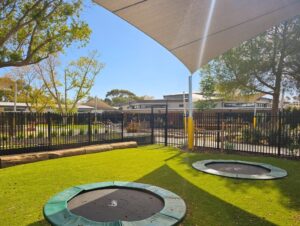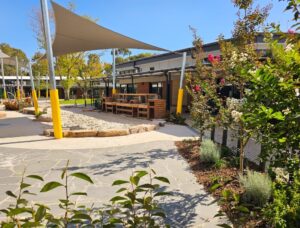
Plants at work in a play space
By Gabrielle Stannus
Who recalls the bruised knees and torn skin from the asphalt jungles of their childhood? I certainly do! That is why, despite having only designed a couple of play spaces myself (which are yet to be built!), I retain a keen interest in the works of others in this space. Hence, when I heard recently that Ruth Czermak from Botanical Traditions was named Landscape Designer of the Year – Commercial Design for her work at Banmira Specialist School, I wanted to know what she did and why. So, I spoke with Ruth about her design journey and how she uses plants in play spaces in educational settings, including those for students with special needs.
Ruth came to landscape design after studying and working in the horticultural industry. She started a retail nursery, Botanical Traditions in Brunswick, well before the hipsters moved into the now famous inner-Melbourne suburb. ‘I was probably ahead of my time because I was selling a lot of productive plants and natives,’ says Ruth. However, the millennium drought was starting to rear its ugly head, and the nursery industry was hit hard. ‘In Melbourne in particular, there was just very little work in that area,’ she continues, ‘So I had to close the nursery, which I loved, but was making absolutely no money.’

Ruth went back to university, gaining her Master of Landscape Architecture, before picking up a tender for Melbourne Water where visiting multiple schools was part of the project. ‘I was quite horrified at what a school environment was like, concrete, no plants, dirt, plastic, horrendous. So, I became very interested in play spaces.’ This interest continued as Ruth continued to focus more on landscape design, still under the name of Botanical Traditions, ‘There was a long period where we did play spaces, and we still do a fair amount in that field. These days, around a quarter of our work is in childcare and play spaces, which is totally different to pre-COVID when this sector formed almost one hundred per cent of our work.’

A very special play space
Ruth’s work on the Banmira Specialist School recently saw her acknowledged as the 2025 Landscape Designer of the Year – Commercial Category at the Landscape Design Institute’s annual awards ceremony. Constructed on the site of the former Wanganui Park Secondary College and opened in January this year, Banmira is a state government educational facility in the northeastern regional city of Shepparton in Victoria. Students at the school have a mild to profound intellectual disability. Many students have multiple diagnoses of disability which may include Autism Spectrum Disorder (ASD), Down Syndrome, Attention Deficit Hyperactivity Disorder (ADHD), associated impairments such as sensory and physical impairments, and/or challenging behaviours.
‘The school’s philosophy is to give the students usable skills,’ says Ruth, ‘So the outdoor area had to allow students to move, play, interact in a safe environment where children need to be able to self-regulate, so there are main playspace areas, as well as smaller breakout areas. It is a very different focus to a normal school environment. Play space supervision is very important, so there are supervision lines everywhere. We designed the landscape so that there are multiple circulation pathways of various scales including quieter areas and more active play areas. We did use equipment on this site as that allows the children to develop upper body strength, for example by climbing and swinging. All these elements were set within a garden setting rather than a huge open space.’
Ruth says that her team had to balance the state government’s preference for native and indigenous plants, with achieving an outcome suiting the diverse needs of the school and its students who are aged from two and a half to 18 years of age. ‘In such a space, you need nice canopy shade trees. You are not going to get that from a eucalypt, and there are only so many Tristaniopsis you can use. You are very restricted in terms of what native trees you can use because they need to be planted in a minimum 50-litre pot size as anything smaller may be destroyed. It is a lot about working within that limitation but thinking “What else would be acceptable and get a better result? Why am I choosing it?” and then being able to justify that to the client.’

Plants as materials
‘I am a landscape architect and horticulturist, but I do not design from the plants first. I use plants just like any other material in a garden. First, when I design a garden, I start thinking about the function. If I have got paving, why do I have paving as opposed to decking? Plants to me are just like that. I will be thinking about the form right from the beginning. So, do I want a tree in this location for shade or screening? Do I want a ground cover, or something a bit taller? Do I want fragrance, what texture am I after? Plants are just like any other materials. We really think of the function that we want first, and then as the design progresses, we will begin to choose the plants based on the function that we want, unless of course a client has a specific request.
‘And then of course, you must consider the practical side of things, making sure that the plant selection is suitable for the soil and other microclimatic conditions and the likely maintenance input. The tricky part is making sure that the plant you want and know would look amazing is available commercially. It is very costly for us, especially on our commercial projects, if we nominate something that the contractor cannot obtain or will not purchase because it is just extra time during construction that we must spend approving substitutions. A lot of the time that work is not really charged; nobody pays you to do that. You just do not have the time to spend days and days tracking the plant down and the client just does not have the budget to allow you to do that either. However, a lot of designers just do it because they want their design to look good or limit their plant selection because they do not want to do it.’

The plants at play
‘Speciality Trees helped us by sourcing a lot of the understorey we wanted for Banmira from other nurseries, and of course provided great trees. They worked on sourcing the plants for probably a nine-month period to ensure availability. We had this huge range of plants, bush tucker, hardy exotics, natives, as well as the indigenous plants, for a variety of spaces within the school grounds. In the more sheltered areas, we used Backhousia citriodora (lemon myrtle), but then in other areas we included Backhousia myrtifolia (grey or cinnamon myrtle). We also had both the creeping salt-bush (Rhagodia spinescens) and the ruby salt-bush (Enchylaena tomentosa). We really tried to use the plants to give a sense of enclosure to all the different spaces.
‘We also used indigenous plants grown locally by Goldfields Revegetation Native Nursery which were on the Shepparton indigenous plant list specific to that area. However, this site is obviously a transformed environment located quite close to an area that floods. The original environment no longer exists on that site. so we chose plants from that list that were able to tolerate current conditions.’
Ruth had to carefully consider irrigation requirements when selecting plants, ‘All the play spaces are irrigated; however, the more public-facing areas such as the carpark are all unirrigated. We therefore had to design very different approaches to each area. Some of the play spaces were on the south side of the building, so they had heavy shade for basically the whole year, whereas other play spaces were very open to the sun on the northern side of the building. We included fast-growing species such as Acacia implexa (lightwood) and Acer negundo ‘Sensation’, the latter which will provide shade quickly. Where we did not have a lot of room but wanted seasonality, such as a play space for the younger children, we used Malus ‘Sugar Tyme’.’
Ruth says that the sensory nature of some of the students’ impairments added an extra layer of complexity to plant selection, ‘Obviously you do not choose any plants that are poisonous. However, you also really need to consider other plants too. For example, a lot of plants have scratchy foliage which, if the students brush up against it, might irritate some of those children because of this sensory aspect. But that does not necessarily mean that you eliminate all those plants from your planting design. You just must be a little bit more careful about where you position them, for instance, grevilleas. Grevilleas can be quite scratchy if you brush up against them; however, they are incredibly hardy plants. We placed them to the back of the beds so students would not be irritated by them, but also to prevent them cutting through areas.

Playground complexity
‘I think a lot of people underestimate how much work and knowledge it takes to develop a playground,’ says Ruth, ‘The Banmira school yard contained existing eucalypts, planted in the seventies, which required large tree protection zones. When we designed the site, we were designing around these 40-year-old eucalypts which added a layer of complexity to the project. In the end, even though we had spent all this time considering the grading and protecting those trees during construction, the decision was made to remove some of those eucalypts. Additionally, we had to work with multiple stakeholders including the school principal, state government representatives, local Aboriginal groups, architects and engineers to realise this project.’
The results speak for themselves. Banmira Specialist School now has a series of very special play spaces that Ruth and her team at Botanical Traditions, and all who worked on this project, can be very proud of. They have shown that a playground can not only meet strict regulations but also exceed best practice, balancing diverse user needs with thoughtful design brought to life through inspired plant selection.
Gabrielle Stannus
Inwardout Studio
M: 0400 431 277
E: gabrielle@inwardoutstudio.com
